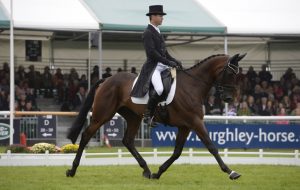After 10 months Jock Paget (pictured above) and his former trainer Kevin McNab have both been cleared of any malpractice after their horses tested positive for banned substance reserpine at last year’s Burghley Horse Trials (5-8 September 2013).
The FEI Tribunal found that the long-term tranquiliser came from a contaminated calming supplement called LesstressE, produced by Trinity Consultants.
Twelve bottles of LesstressE were obtained from the stables of Jock Paget, Kevin McNab, Adam Trew and Jonelle Richards for testing and reserpine was detected in 10 of them.
The FEI countered by claiming the bottles had a “simple flip top lid” so could have been tampered with after leaving the manufacturers.
The FEI claimed Jock would have “strong motivation” to do this, given that reserpine is known to have a calming effect for dressage and he had admitted that Clifton Promise was “highly strung”.
Director of Trinity Consultants Roger Hatch admitted mixing LesstressE “to order” on his kitchen table using a “wooden spoon and plastic bowl” and that there was no quality control. Due to the nature of the manufacturing process it was impossible to prove exactly how and when the contamination occurred.
The Tribunal also found that neither rider had shown “negligence” because they couldn’t have “reasonably known or suspected” that LesstressE would be contaminated with reserpine.
Moving on
Although still stripped of his Burghley title, Jock is now free to ride again, as is Kevin, both escaping a potential two-year ban.
Jock can now concentrate on preparations for the Alltech FEI World Equestrian Games. He was selected for the New Zealand squad earlier this summer.
“It is the ultimate relief. It has been the only thing on my mind,” Jock told H&H.
“I was fortunate that we were able to find the source of the contamination, trace it and prove — most importantly — that I wasn’t responsible nor could I have known.”
 Kevin (pictured left riding Clifton Pinot) is also keen to “finally move on”.
Kevin (pictured left riding Clifton Pinot) is also keen to “finally move on”.
“I’m not a doper, I always knew it had to be contamination,” he said.
Both horses are owned by Frances Stead of Clifton Eventers, who has maintained both riders’ innocence throughout.
“This outcome confirms what we have consistently said since this news broke last year — that both Jock and Kevin are two exceptional individuals who are not only very talented and hard-working, but also operate at all times in an ethical and honest way,” said Frances in a statement.
“It is also great news for the sport of eventing, as it confirms it remains clean of any drug abuse of horses.”
Supplement concern
The case has once again thrown into the spotlight the possible problems with contamination in supplements.
It was revealed that Clifton Promise was on seven supplements and that Clifton Pinot had been given three different calmers — including LesstressE — on the morning of the dressage at Burghley (6 September).
The FEI argued that under the context of the World Anti-Doping Code, athletes had been warned supplements may be contaminated with prohibited substances. As a result, the riders had “assumed the risk” by still using them.
“This case highlights the much discussed concerns about the use of herbal supplements,” said H&H vet consultant Karen Coumbe. “It can be extremely difficult to know for certain what precisely the contents are and how they are manufactured.”
Event Riders Association president Bruce Haskell added: “This is a wake-up call that riders need to be more responsible.”
LesstressE was still available on the Trinity Consultants website for £17 last week with claims to contain no prohibited substance for either the FEI or national equine ruling bodies, but it has since been de-listed.
H&H asked Mr Hatch why LesstressE had still been available and if he could confirm his products were no longer at risk of contamination. Mr Hatch refused to comment on the contamination risk.
Standing up to scrutiny
The high-profile nature of this case has put the FEI Tribunal system under widespread public scrutiny.
The organisation has been criticised during the past 10 months for the amount of time it took to process the case.
In March, Olympic event rider Ian Stark told H&H the FEI disciplinary system “really needs tightening-up”.
“The FEI lets things linger on and on. Eventing needs to work on this, when cases hang on, it can have adverse effects on people’s careers,” he said (news, 6 March).
Jock’s elimination from Burghley after a “partial decision” by the FEI did not happen until 23 April — the day before Kentucky three-day event where Andrew Nicholson was attempting to win the second leg of the Rolex Grand Slam, having finished second to Jock at Burghley.
The length of the case has also resulted in Jock and Kevin missing several major events.
Concerns have now been raised that the FEI’s approach to the case was defensive rather than investigative.
“I would like in future to see the FEI take a strong investigatory role following initial positives and to do so at an early stage to ensure that in cases where there is no fault, such as Kevin’s, these cases can be identified and resolved much more quickly,” said Kevin’s lawyer Rory Mac Neice.
“The process needs to be more streamlined,” added Jock’s lawyer Jeremy Dickerson. “It’s the right result, but it’s taken us a jolly long time to get there.”
“More money and time needs to be spent across the board,” added Bruce Haskell. “We all want a fair sport and that requires a combination of the athlete and the administration.
“If we want eventing to stay as an Olympic sport we need it to be credible. Cycling now has no credibility, weightlifting now has no crediblilty and I would hate to see eventing go the same way. It requires both sides to play within the rules and get better at what they do.”

